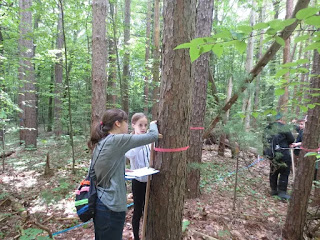
Our Changing Forests Field Work
 |
| Students measured the diameter of trees in 10 x 10 meter study plots at Harvard Forest for the Our Changing Forests Schoolyard Ecology project. |



Some interesting discoveries near the study plots included a tree frog, mushroom, Red Eft Salamander and oak gall.
We learned about major changes happening in this part of the forest. In looking up to estimate the percent of canopy cover for the field survey, we saw that many of the biggest trees in the plot were dying. This was an old Red Pine plantation that was planted when Harvard Forest was a Forestry School. As the the old plantation trees are dying and other species are finding enough light to sprout and grow
Hemlock and Oak are some of the new species growing as the dying Red Pine open up the forest floor.


We looked at the difference between red and white pine cones and needles.


We recorded whether we saw snapped trees and/or uprooted trees as indicators of weather damage in our study plots.
Left: We recorded signs of Wildlife such as this stash of pine cones indicating that a squirrel or chipmunk has been looking for pine cone seeds.
Right: We tasted the wintergreen flavor of the inner bark of the Sweet Birch trees near the plot.
Fisher Museum Dioramas
Students also had a chance to learn more about Land Use Change by seeing the story of how the forests were cleared in the 1700-1800s and began to grow back again after farm abandonment later on. First dominated by White Pine, cut again and then grew as Hardwood dominated forests.
Thanks to ARMS PTO representative, Stacey Bellabarba and staff person, Elaine Gauthier for photo contributions.
What does the Data Show?
Red Pine, Red Oak and Red Maple are storing lots of Carbon presently as Red Pine continue to dominate this area of the forest. Also there is not much species diversity in these plots due to its history as a plantation. It will be interesting to see that as the forest is left unmanaged by humans, how the species dynamics and growth will change over time. As we collect data over time, I would expect that Red Pine bars will become shorter and shorter, and other species will become larger. I would also expect that some species not yet represented here, will begin to sprout and grow in these plots. Therefore I would expect more bars to appear on future graphs. However disease and weather can cause unexpected "disturbance" in the forest at any time, so stay tuned by checking our database over time to track future changes.
Thanks to Highstead Foundation for Supporting this field trip with funding for the Our Changing Forests Field Trip Scholarship.
Thanks to Highstead Foundation for Supporting this field trip with funding for the Our Changing Forests Field Trip Scholarship.
Explore More:
To Graph More Data , choose Our Changing Forests project and choose field sites 5-8 on our online database.
Download Data to see the data in table form.
Check out our Interactive Field Site Map to see all Schoolyard Ecology Field Sites that are contributing to our studies. You can select Our Changing Forests to see only those schools participating in this particular study.
Go to Our Changing Forests Project Webpages to learn more about the Our Changing Forests project and protocol.
To join our Network of Schoolyard Ecology, we invite teachers from throughout the North East to
Apply for a Field Trip Scholarship


















